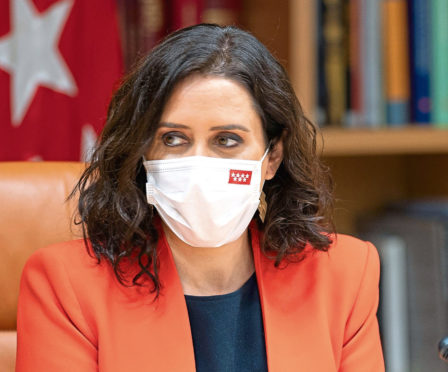
Sitting at a bar with a cool beer in the buzzing streets of Malasaña, it almost seems as if the Covid-19 pandemic is over.
Pubs are full of drinkers without masks and there is a queue for a chance to enjoy a “copa” – a drink – with friends in this fashionable inner city area of Madrid. The streets and bars are packed as the clock ticks towards midnight.
The Spanish capital has enjoyed some of the laxest pandemic restrictions in the country thanks to a political battle between the region’s maverick conservative leader, Isabel Diaz Ayuso, and Spain’s left-wing coalition government which has tried to enforce restrictions in the hope the country can return to some semblance of normality.
With a battle cry of “Freedom or Communism”, Ayuso won bitter regional elections in May by tuning in to Madrileños weariness with the pandemic and the endless restrictions it brought. Now, the two sides are pitted against each other again after the Spanish Government brought in a national traffic-light system to try to avoid a repeat of last summer’s mistakes in which restrictions were relaxed, everyone partied and a second wave swiftly followed.
The new system means regional governments, which have a large control over Covid-19 restrictions, must adopt measures according to coronavirus contagion rates and how overloaded the hospitals are.
The political row comes as Spain’s contagion rate has been falling steadily and the vaccine roll out picks up pace. Though a long way behind the UK, Spain has vaccinated 38% of the population. Ten million people have had both doses.
Health leaders expect to start rolling out the one-shot Janssen vaccine this month and the target is to vaccinate 70% of the population by August 18.
Madrid, which had a 14-day contagion rate of 160 per 100,000 people on Thursday compared to the national figure of 118, falls into the “high-risk category” according to the new system. However, current restrictions in the city correspond to a region in what is classed as the “new normality” category. This means the two-week contagion rate is below 50.
Currently in the Spanish capital, eight people can dine together outside, six inside. Bars and restaurants, which must close at 1am, are allowed 75% capacity outside and 50% inside. Gyms and other sporting centres must close at midnight. Shopping centres, conference centres and other areas for people to meet have no limit on capacity.
The Spanish Government’s determination to get tough with regional politicians has not gone down well. Ayuso has led a chorus of protest from other regions including Catalonia, Andalusia, Murcia and the Basque Country, home to more than half the country’s population of 47.5 million.
“This rule is not mandatory and can not be enforced. We are talking about a political imposition that is not based on health and is arbitrary,” she said.
Madrid has vowed to appeal against the regulations in the courts. To comply would mean banning people from going inside bars or restaurants at night time, until the capital’s contagion rate falls considerably.
Meanwhile, the Spanish Government is determined to save some of the summer season for the hard-hit tourism sector – which accounts for 13% of GDP. Health Minister Carolina Darias said: “What’s important is finishing off what we are achieving.”

Enjoy the convenience of having The Sunday Post delivered as a digital ePaper straight to your smartphone, tablet or computer.
Subscribe for only £5.49 a month and enjoy all the benefits of the printed paper as a digital replica.
Subscribe